
FEBRUARY- MAY 2025



FEBRUARY- MAY 2025




During February to May 2024 the SWT/KWS Sky Vet program was called to handle 27 wildlife cases involving 21 elephants, 3 giraffes, 2 rhino cases and a buffalo with poaching being the most common cause for treatment
17 elephants suffered poaching injuries; 6 with arrow wounds, 2 for bullet wounds 7 with spear wounds and 2 with snare injuries There were also 2 that were attended to due to Human-Wildlife Conflict (HWC) and 2 for natural causes One of the juvenile elephants with a severe spear injury was taken to the Voi Stockades as he was vulnerable with no herd nearby and would need several treatments. He is doing well despite being an older elephant. An elephant with a bullet wound and another with a spear wound were given guarded prognosis whereas the others were successfully treated with a good prognosis for recovery.
There were three HWC involved relocation of a Black rhino that escaped from Nairobi National Park into community land and relocation of an elephant bull that had wandered into Community land in Tsavo. Another elephant was also treated for a spear wound most likely caused by HWC. Other cases attended to included 3 giraffes (1 snared, 1 speared and 1 for natural causes), a snared buffalo, and another rhino for natural causes.
Out of the cases treated there was an overall 89% success rate.
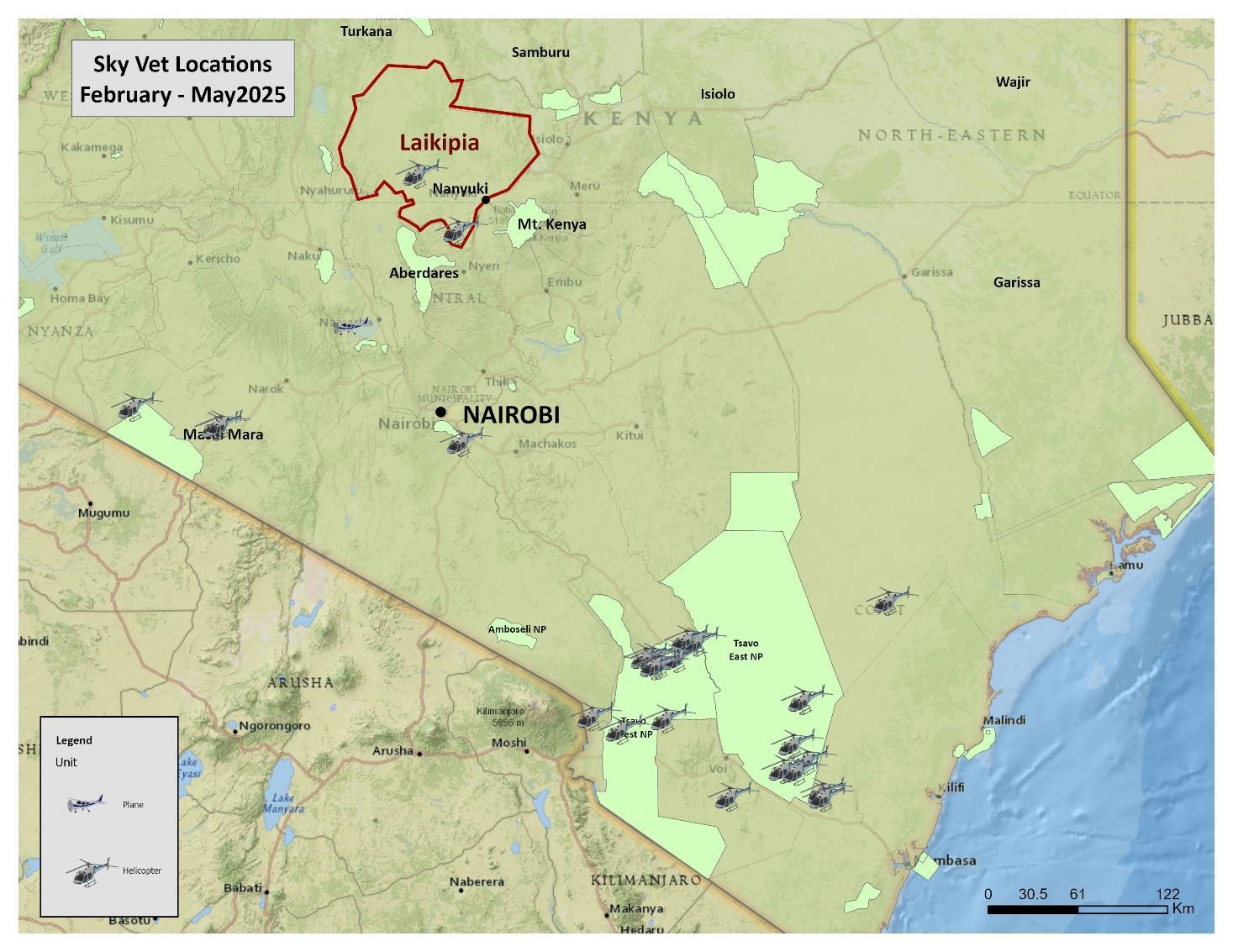
27
February - May 2025
Outcomes of Cases attended to by SWT/KWS Sky Vet Unit
February - May 2025

This young elephant was spotted by a KWS team in the Balguda area, she had a wire snare on her left fore limb, and the snare had inflicted deep injuries around the area.


Immobilisation, examination and treatment
She was successfully immobilized using 5mg Etorphine hydrochloride delivered remotely in a 1.5 cc Daninject dart. Darting was done from the vehicle, and it took 6 minutes for the drugs to achieve its full effects.
Examination revealed a wire snare on the distal left forelimb. The snare had inflicted a deep septic wound at the area. The wire snare was cut using wire cutters, followed by thorough cleaning of the wound. The wound was thereafter flushed with Hydrogen peroxide then rinsed and infused with tincture of Iodine. Green clay and topical antibiotic spray were also applied on the wound.
The elephant additionally received Amoxicillin antibiotics and Flunixin anti-inflammatories parenterally.
Reversal and prognosis
She was reversed from anaesthesia using 100mg Naltrexone hydrochloride delivered intravenously via a prominent ear vein. She rose and walked away 3 minutes later Prognosis is good. .


Elephant Spear Galana, Tsavo East National Park
This injured elephant was spotted by the SWT pilot, he was limping and had a swollen left forelimb.


Immobilisation, examination and treatment
This calf was successfully immobilized from foot using 6mg Etorphine.
Examination revealed a penetrating septic spear wound on anterior surface of the left carpal joint. There was active joint infection with pus within the joint capsule. The wound was thoroughly cleaned and the pus evacuated from the joint. This was followed by flushing with Hydrogen peroxide and infused with tincture of iodine, antibiotics and topical antibiotic spray applied. Additionally, he received shots of Amoxicillin, Clindamycin antibiotics and Flunixin anti-inflammatory medication parenterally.
Prognosis
He was taken to the SWT Voi elephant stockade for monitoring and repeat treatments since he had been neglected by his family. He was reviewed on the 20th February and examination revealed that pus had accumulated. The wound was thoroughly cleaned with water, Hydrogen peroxide and infused with Iodine. The wound was thereafter packed with antibiotic pessaries and sprayed with a topical antibiotic. He also received shots of Amoxicillin, Clindamycin antibiotics and Flunixin anti-inflammatories parenterally


.
This was a female elephant in Olkinyei with arrow injury on the right forelimb. The Unit was assisted by the SWT helicopter.


A dart was prepared, and he was successfully darted on the hind quarters with 10mgs Etorphine. Upon immobilisation, both ears were used to cover the left and right eye shielding it from direct sunlight and dust. Water was doused on the animal to cool him down as the temperatures continued rising.
The arrow was retrieved, and the wounds were cleaned with water, then cauterized with Hydrogen peroxide and lavaged with povidone Iodine. Topical antibiotic cream and spray was applied. Systemically the elephant was given 30,000mg of Oxytetracycline and 50mgs Dexamethasone administered intramuscularly.
Revival and prognosis
The elephant was revived using 170mgs Naltrexone into the ear vein and a third of the drug intramuscularly. Prognosis is good.


Elephant Snared Kaluku, Tsavo
This elephant was spotted by the SWT pilot during routine patrols in Kaluku area having a wound on the trunk suspected to have been caused by a snare.
Immobilisation, examination and treatment
This bull was successfully darted from a helicopter using 20mg Etorphine hydrochloride delivered remotely in a 3cc Dan inject dart, and it took 8 minutes for the drug to achieve its full effects.
Examination revealed a cable wire snare that had inflicted a wound on the trunk. The wire snare was immediately cut using wire cutters.
The wound was thereafter cleaned thoroughly with water and infused with tincture of Iodine and then topical antibiotic spray applied.
Reversal and prognosis
He was reversed from anaesthesia using 200mg of Naltrexone hydrochloride given intravenously via a prominent ear vein. He rose 3 minutes later. Prognosis is good.




Buffalo Snared Sala, Tsavo East
This buffalo was spotted by the SWT rangers in Sala area having a snare on his neck dragging a log attached to the snare.
Immobilisation, examination and treatment
He was successfully immobilized using 8mg Etorphine hydrochloride and 60mg of Azaperone delivered remotely in a 3cc Dan inject dart. Darting was done from the helicopter, and it took 7 minutes for the drugs to achieve its full effects.
Examination revealed a winch wire snare on the neck, luckily the snare had not inflicted wounds on the neck. The wire snare was cut using wire cutters and the bruises topically sprayed with an antibiotic spray.
Reversal and prognosis
He was reversed from anaesthesia using 80mg of Naltrexone hydrochloride given intravenously via jugular vein. He rose 3 minutes later. Prognosis is good.


A Black rhinoceros had strayed away from Nairobi NP for a least one month into a community area (Sheep& Goats area) – Kitengela community). This was a security threat to the rhino and emergency translocation was carried with necessary approval(s) to a safe area (Tsavo West NP)
The rhino was searched for with the support of a helicopter in the Kitengala area and pushed to Sheep & Goats area, then darted in a open grassy plain from the helicopter with Etorphine and Azaperone.
The immobilized rhino was quickly put on sternal recumbency then rapidly administered intravenously 5mg Butorphanol plus 20mg Doxapram, to ensure stable and safe levels of anaesthesia. The rhino’s respiration was supplemented with oxygen. Vital parameters were monitored and a top up of 2.5mg Butorphanol was carried to further stabilize the level of anaesthesia for loading manipulations. The rhino was blind-folded, and ears blocked with plugs to reduce capture stress. The rhino was ear tagged, and samples collected for the National Rhino Database. After reversal of anaesthesia the rhino was then loaded onto a translocation crate and lifted using a crane onto the transport lorry and transported the same day to Tsavo West NP. The rhino was safely released at IPZ – Rhino Valley area.




.
Elephant Spear
Attended to reported elephant case in Tsavo West National Park with a spear injury at the hip.


Immobilisation, examination and treatment
The elephant was immobilized with 15mg Etorphine hydrochloride and assessed for injury.
The spear injury was at the hip, infected, and oozing pus on manipulation. The wound was cleaned with water, Hydrogen peroxide and lavaged with Iodine, then it was covered with topical antibiotic cream and spray.
Th elephant was also administered an anti-inflammatory: 60 mgs of Dexamethasone, antibiotics: 3,000mgs Oxytetracycline
Reversal and prognosis
The 300mgs antidote was administered intravenously, and the elephant was up after a few minutes of administration. Prognosis is good.


Elephant Bullet Wound
This case was reported by Olkinyei Conservancy through MEP.
Immobilisation, examination and treatment
Olkinyei Conservancy
We darted the mother by driving the calf and mother from a dense forest using MEP Helicopter. We pushed away the calf using the helicopter and ensured the safety of the ground team by the same helicopter. The mother elephant was darted from the helicopter with 16mg Etorphine.
On examination the female elephant was suffering from four (4) communicating suppurative gunshot wounds to the left hind leg. The bullet wounds had caused severe injuries to the leg and severe lameness. The wounds were cleaned with water, cauterized with dilute hydrogen peroxide and rinsed with plenty of normal saline and tincture of Iodine. A fly repellant (Alamycin® Aerosol) was also applied. The elephant was adminster 15,000mg Betamox ®(Amoxicillin), 1,000mg Flumeg (Flunixin) and 80ml Butasal by IM route
Reversal and prognosis
We reversed the elephant from anesthesia using 250mg of Naltrexone given by IM and IV route. The calf was just waiting for the mother to wake up 50 meters away and they were successfully reunited. Prognosis of this case is guarded tending to poor. We advised closed monitoring of the injured elephant.




Elephant Spear Komboyo, Tsavo West
This injured elephant was spotted by the SWT pilot during patrols in with a wound on the left hind limb.


Immobilisation, examination and treatment
This bull was successfully immobilized using 18mg Etorphine hydrochloride delivered remotely in a 3cc Dan inject dart. Darting was done from a helicopter, and it took 15 minutes for the drug to achieve its full effects.
Examination revealed a septic spear wound on the proximal left hind limb. The wound was thoroughly cleaned and the pus evacuated from the wound. This was followed by flushing with Hydrogen peroxide and rinsing the wound thoroughly with water, the wound was thereafter infused with tincture of Iodine, packed with antibiotic pessaries and topical antibiotic spray applied. Additionally, he received shots of amoxicillin antibiotics parenterally.
Reversal and prognosis
He was reversed from anaesthesia using 180 mg of Naltrexone hydrochloride given intravenously via jugular vein. He rose 3 minutes later Prognosis is good. .
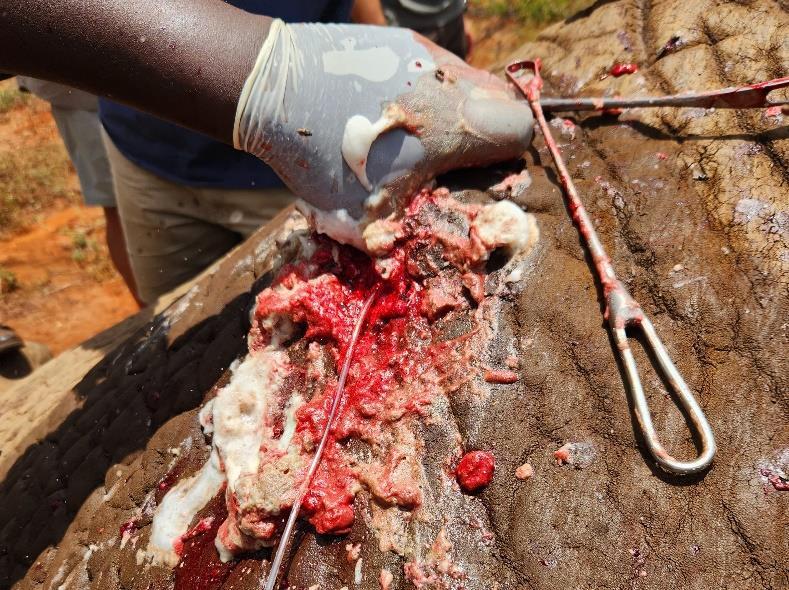

10 – 30th March 2025
This injured elephant was spotted by the SWT pilot during patrols in the Shirango area having a wound on the left flank area.
Immobilisation, examination and treatment
This bull was darted from a vehicle with 20mg Etorphine hydrochloride delivered remotely in a 3cc Dan inject dart. It took 15 minutes for the drug to achieve its full effects.
Examination revealed a septic arrow wound on the left flank area. The wound was thoroughly cleaned and the pus evacuated from the wound. This was followed by flushing with Hydrogen peroxide and rinsing the wound thoroughly with water, the wound was thereafter infused with tincture of Iodine and topical antibiotic spray applied.
He also received shots of Amoxicillin and Flunixin anti-inflammatories parenterally.
Reversal and prognosis
He was reversed from anaesthesia using 200mg of Naltrexone hydrochloride given intravenously via jugular vein. He rose 3 minutes later. Prognosis is good.


Snared Wileli, Naivasha
The SWT de-snaring Team in Naivasha reported a giraffe in Wileli Conservancy dragging a long wire snare attached to a log on its leg. While the snare had not caused an open wound, the giraffe was limping, visibly distressed, and had a swollen leg. A veterinarian from KWS HW was deployed to attend to the giraffe.
Chemical immobilization and roping during the final stages of anaesthesia induction is the preferred method for capturing giraffes. The opioid Etorphine and Azaperone, a sedative, were administered using a Dan-Inject darting system. Induction time was prolonged, likely due to subcutaneous drug discharge. The giraffe was roped to the ground after 18 minutes. Immobilization effects were fully reversed by intravenous administration of Naltrexone hydrochloride, a complete opioid antagonist and the giraffe was physically restrained by firmly holding its neck to the ground. The neck was extended to maintain a patent airway, and a quick examination confirmed that vital parameters were within normal limits.
A tight plain wire snare was present distal to the left leg joint causing bruises and edema. The snare was removed with a wire cutter and non-steroidal anti-inflammatory drugs were administered parenterally.
The giraffe was assisted to a standing position with a good prognosis.




A male elephant was found with a pus-oozing wound and reported to AMVU. The vet team travelled to the Satao area using SWT aircraft and immobilised the bull for examination and treatment.


Immobilisation, examination and treatment
The elephant was successfully immobilised using 20mg of Etorphine HCl. The dart was incidentally placed under the skin, but the bull attained full immobilisation in 23 minutes.
The elephant had an old wound on the left part of the flank. The wound was pus-filled and had formed a slight bump. The swelling was cut, and the pus was drained. A cut was made on the lower part of the wound to clear extra discharge. The wound was debrided using forceps and Hydrogen peroxide. Oxytetracycline spray was applied locally.
Prognosis
The elephant was revived using Naltrexone (an antagonist for the immobilisation drug) and favourably woke up shortly after drug administration. The elephant successfully moved away after revival. Prognosis is good. . .
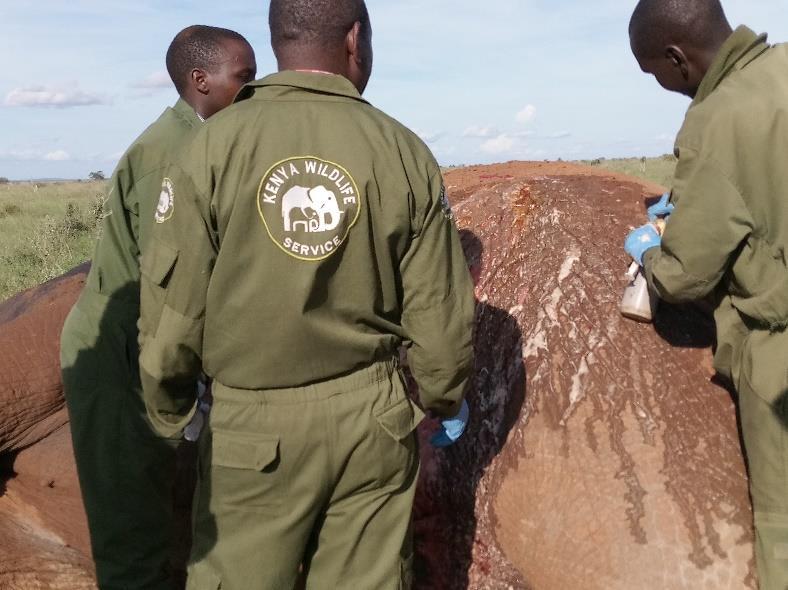

This elephant was spotted by the Wildlife Works Rangers during routine patrols in Sagala ranch having a wound on the right forelimb. TMVU was alerted and responded immediately to the case.


Immobilisation, examination and relocation
This bull was successfully immobilized using 18mg Etorphine hydrochloride delivered remotely in a Dan inject dart. Darting was done from a helicopter, and it took 8 minutes for the drug to achieve its full effects.
Examination revealed a deep septic spear wound on the medial right carpal metacarpal joint. The wound was thoroughly cleaned, flushed with Hydrogen peroxide and infused with tincture of Iodine. The wound was thereafter packed with antibiotic pessaries and sprayed with a topical antibiotic. He also received shots of Amoxicillin, Clindamycin antibiotics and Dexamethasone anti-inflammatory parenterally.
Reversal and prognosis
He was reversed from anaesthesia using 180mg Naltrexone hydrochloride given intravenously via a prominent ear vein. He rose 3 minutes later and moved away. Prognosis is guarded.


This elephant was spotted by the SWT pilot during routine patrols in Komboyo area having poor body condition. TMVU was notified and responded immediately to the case.
Immobilisation, examination and treatment
This elephant was successfully immobilized using 18mg Etorphine delivered remotely in a 3cc Dan inject dart. Darting was done from a helicopter, and it took 10 minutes for the drug to achieve its full effects.
Examination revealed an elephant in satisfactory body condition having slightly deteriorated compared to pre-translocation status. The elephant had been translocated from Tana River. He was previously fitted with a collar which was removed and supportive treatment given. He received Amoxicillin antibiotic, a metabolic stimulant and Dexamethasone anti-inflammatory parenterally.
Reversal and prognosis
He was reversed from anaesthesia using 180mg Naltrexone hydrochloride given intravenously via a prominent ear vein. He rose 3 minutes later and moved away. Prognosis is fair.

This injured elephant was spotted by the SWT pilot during patrols in Komboyo area with a wound on the trunk, neck and another on the left rump.
Immobilisation, examination and treatment
This bull was successfully immobilized from a helicopter using 18mg Etorphine hydrochloride delivered remotely in a 3cc Dan inject dart, and it took 8 minutes for the drug to achieve its full effects.
Examination revealed a septic arrow wound on the neck, left rump and an extensive wound at the trunk. The neck and left rump wounds were thoroughly cleaned and the pus evacuated. This was followed by flushing with Hydrogen peroxide and rinsing the wound thoroughly with water, the wound was thereafter infused with tincture of Iodine, packed with antibiotic pessaries and topical antibiotic spray applied.The trunk wound was cleaned, infused with tincture of iodine then sprayed with a topical antibiotic. The wounds at the trunk appeared to have been inflicted using a machete. Additionally, he received shots of Amoxicillin antibiotics and Dexamethasone anti-inflammatory parenterally.
Reversal and prognosis
He was reversed from anaesthesia and given a good prognosis.
.

16 – 26th April 2025
This elephant bull was spotted by SWT and KWS rangers in Dakadima area having a wound on the upper thigh of the left hind limb. TMVU was notified and responded quickly to treat the animal.
Immobilisation, examination and treatment
This bull was successfully immobilized from a helicopter using 20mg Etorphine with a top up of 10mg Etorphine delivered remotely in a Dan-inject dart. It took 15 minutes for the drug to achieve its full effects.
Examination revealed a deep septic spear wound on the lateral upper thigh of the left hind limb. The wound was thoroughly cleaned and the pus evacuated from the wound. All devitalized tissues within the wound were debrided, this was followed by flushing with Hydrogen peroxide, rinsing thoroughly with water then infusing it with Iodine and packing it with antibiotic pessaries. Topical antibiotic spray was applied thereafter. Other treatments given include parenteral administration of Amoxicillin and Clindamycin antibiotics. The elephant also received shots of Dexamethasone anti-inflammatory
Prognosis
He was revived using 200 mg of Naltrexone hydrochloride given intravenously via a prominent ear vein. He rose 3 minutes later. Prognosis is good.


This giraffe was spotted by KWS rangers and Big Life Rangers in Rombo having a spear head lodged in his left hindlimb.
Immobilisation, examination and treatment
This giraffe was successfully immobilized using 13mg Etorphine hydrochloride and 60mg Azaperone delivered remotely in a 3cc Dan inject dart. Darting was done from a helicopter and it took 8 minutes for the drug to achieve its full effects.
Examination revealed a spear which had injured the Achilles’. The spear head fell out during the knockdown of the giraffe by the tranquillizer. The spear wound was septic. The wound was thoroughly cleaned and the pus evacuated from the wound. This was followed by flushing with Hydrogen peroxide, rinsing the wound thoroughly with water, then it was infused with Iodine and topical antibiotic spray applied thereafter. Additionally, she received shots of amoxicillin parenterally.
She was reversed from anaesthesia using 130mg Naltrexone hydrochloride delivered intravenously via the jugular vein. She rose and hastily walked away 3 minutes later. Prognosis is good.


Elephant Spear Ziwani, Tsavo West National Park
This injured elephant was spotted limping on his right forelimb at Ziwani area by the SWT pilot during the routine patrols.
Immobilisation, examination and treatment
This bull was immobilized using 20mg Etorphine hydrochloride delivered remotely in a 3 cc Dan-inject dart. Darting was done from the helicopter, and it took 10 minutes for full anaesthesia to be achieved.
Examination revealed a septic spear wound on his right forelimb. The wound was thoroughly cleaned, debrided, flushed with Hydrogen peroxide, rinsed with clean water, infused with tincture of Iodine and then packed with antibiotic pessaries and a topical antibiotic spray was applied on the wound.
He was additionally given amoxicillin antibiotics and anti-inflamatories parenterally.
Prognosis
He was reversed from anaesthesia using 200mg Naltrexone hydrochloride given intravenously via a prominent ear vein. He rose few minutes later and slowly walked away. Prognosis is good.




This injured elephant was spotted by the SWT pilot during patrols in Satao area (dika plain) with a wound on the left flank.

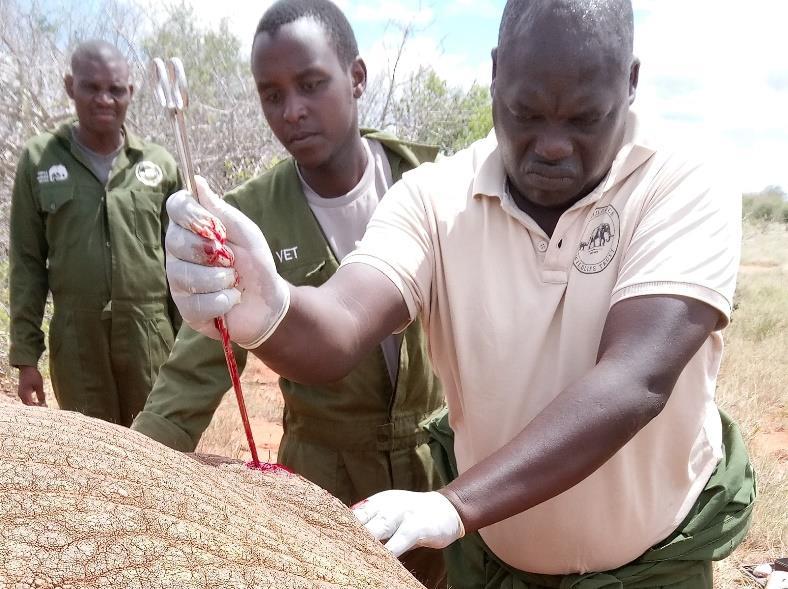
Immobilisation, examination and treatment
This bull was successfully immobilized from a helicopter using 20mg Etorphine hydrochloride delivered remotely in a 3cc Dan inject dart and it took 10 minutes for the drug to achieve its full effects.
Examination revealed a deep septic arrow wound on the left flank area. The wound was thoroughly cleaned and the pus removed from the wound. This was followed by flushing with Hydrogen peroxide and rinsing the wound thoroughly with water. The wound was thereafter infused with tincture of Iodine, packed with antibiotic pessaries and topical antibiotic spray applied. Additionally, he received shots of Amoxicillin antibiotics parenterally.
Prognosis
He was reversed from anaesthesia using 200mg Naltrexone hydrochloride given intravenously via a prominent ear vein. He rose few minutes later and slowly walked away. Prognosis is good.


This injured elephant was spotted by the SWT pilot during patrols in Dakota area injured and limping.
This bull was successfully immobilized using 20mg Etorphine hydrochloride delivered remotely in a 3cc Dan inject dart. Darting was done from the helicopter, and the elephant went down 8 minutes later.
Examination revealed a deep septic arrow wound on the medial side of the proximal left forelimb; a deep septic arrow wound on the medial aspect of the left carpal joint which on probing the wound, a foreign body was found, retrieved and positively identified to be an arrowhead. Another septic arrow wound was found on the lateral aspect of the right proximal forelimb.
All wounds were thoroughly cleaned, debrided, flushed with Hydrogen peroxide, rinsed with water and infused with tincture of Iodine. The wounds were thereafter packed with antibiotic pessaries, and a topical antibiotic spray was applied on the wounds. He was additionally given Amoxicillin antibiotics parenterally.
Prognosis
He was reversed from anaesthesia, and he rose 3 minutes later and slowly walked away. Prognosis is good.




This injured elephant was spotted being wounded on the right flank in Dakota area by the SWT pilot. TMVU was notified and responded immediately.


Immobilisation, examination and treatment
This elephant was successfully immobilized using 21 mg Etorphine hydrochloride delivered in a 3cc Dan inject dart. Darting was done from the helicopter and it took 10 minutes for the drug to achieve its full effect.
He received a shot of dexamethasone intravenously and loaded on to the flatbed truck and relocated to Kaluku area.
Prognosis
He was reversed from anaesthesia using 200mg Naltrexone hydrochloride given intravenously via a prominent ear vein. He rose few minutes later and slowly walked away. Prognosis is good.


This elephant was spotted and reported by SWT pilot and KWS rangers to have wandered into the community area in Ngiluni.


Immobilisation, examination and treatment
This elephant was successfully immobilized using 21mg Etorphine delivered in a 3cc Dan inject dart. Darting was done from the helicopter, and it took 10 minutes for the drug to achieve its full effect.
He received a shot of Dexamethasone intravenously then loaded on to the flatbed truck and relocated to Kaluku area.
Prognosis
He was revived from narcosis using 210 mg Naltrexone hydrochloride given intravenously via a prominent ear vein. He rose and slowly walked away 3 minutes later. Prognosis is good.


23 – 16th May 2025
Elephant Natural Causes
Kangechwa, Tsavo West NP
This injured elephant was spotted limping on his right forelimb at Kangechwa area by the SWT pilot.
Immobilisation, examination and treatment
This bull was immobilized from a helicopter using 19mg Etorphine hydrochloride delivered remotely in a 3cc Dan inject dart. It took 10 minutes for full anaesthesia to be achieved.
Examination revealed that the bull had dislocated his right carpus a while ago which appeared to have healed.
He received shots of Amoxicillin antibiotic and an anti-inflammatory parenterally.
Reversal and prognosis
He was reversed from anaesthesia using 190mg Naltrexone hydrochloride given intravenously via a prominent ear vein. He rose few minutes later and walked away into the bushes. Prognosis is good.

This elephant had a young calf and had been recumbent for a while due to spear wounds on the left hindlimb, right rump and on the left forelimb.
Immobilisation, examination and treatment
Chemical immobilization was used for the adult while her calf was restrained physically. The elephant was darted from a helicopter with 17mg Etorphine. Induction time was 10 minutes.
The wound was first washed with water then lavaged with Hydrogen peroxide to clear out any organic matter and thereafter flushed with Iodine. 2,400 mg of Alamycin long-acting antibiotic was administered as an antibiotic, 5,000mg Flunixin Meglumine as an analgesic and 100gm Ivermectin as an anthelmintic against internal and external parasites.
Prognosis
Naltrexone (400mg) was administered to reverse the antibiotic and mother, and calf were reunited. Prognosis is fair. This case is an example of human wildlife conflict. Spear wounds are usually a result of the punishments /deterring of elephants that are involved in crop raiding and perceived conflicts.




This giraffe was spotted by visitors at the park being injured and limping on his left forelimb. TMVU was informed and responded immediately.
Immobilisation, examination and treatment
This giraffe was successfully immobilized using 13mg Etorphine hydrochloride and 6omg Azaperone delivered remotely in a 3cc Dan inject dart. Darting was done from the helicopter and it took 8 minutes for the drug to achieve its full effects.
Examination revealed an ulcerated papillomatous lesion on the left distal forelimb. The wound was cleaned with water and all maggots removed, flushed with Hydrogen peroxide and disinfected using tincture of Iodine. He was additionally given Amoxicillin antibiotic parenterally.
Prognosis
He was revived using 130mg Naltrexone hydrochloride given intravenously via the jugular vein. He rose 3 minutes later and walked away. Prognosis is fair.
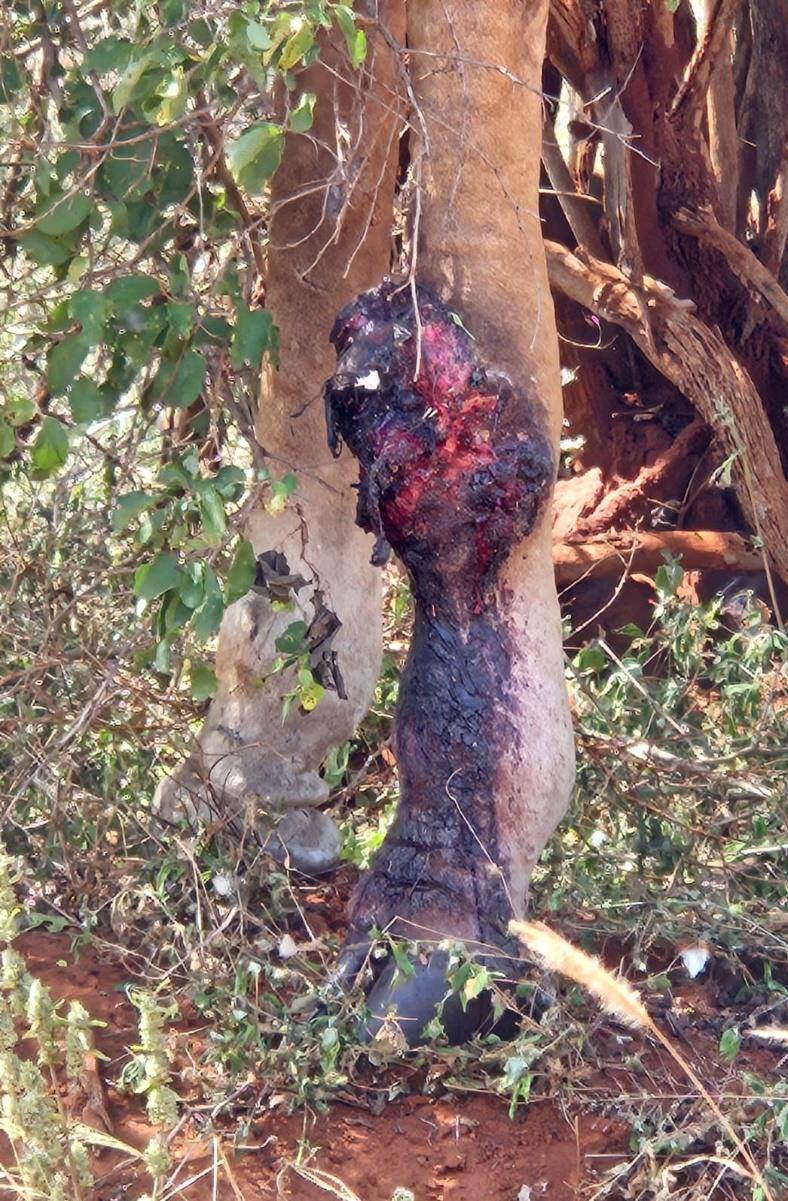


The adult white rhino was reported to the Vet Unit to have sustained injuries from territorial fights by the Solio Ranch veterinary unit. The intervention necessitated the use of a helicopter for quick intervention.

Immobilisation, examination and treatment
The adult male white rhino was identified and immobilized with 4mgs Etorphine hydrochloride and 60mgs of Azaperone hydrochloride. After a few minutes of darting with the immobilization drug, the rhino showed signs of a hackney gait, showing immobilization. An attempt was done to physically bring down the rhino to a sternal recumbency by tying the hind limbs with a rope and physically pushing to its side
The rhino had multiple fight injuries to the buccal cavity, right and left forelimb, right hindlimb, and inguinal region with a body score of 3/5. The wounds were cleaned with Hydrogen peroxide and Iodine, then a topical antibiotic spray was applied. The rhino was also given 1,000mg Flunixin, 3,000mg Amoxicillin and Chloretracycline pessaries.
Reversal and prognosis
Prognosis is good. Monitoring was advised to check on the progression and recovery of the male rhino.

A report was received of an injured adult male elephant within Laikipia County. Upon locating the animal, a visual examination confirmed that the gait was deliberate, with a one-step-at-a-time approach, favouring the left forelimb. The animal exhibited restlessness and reluctance to bear weight on the affected limb.
The elephant was immobilized with 17mgs Etorphine hydrochloride and assessed for the location and extent of injury caused. There was a massive swelling at the carpal joint of the right forelimb, oozing pus on manipulation. The nature of the injury suggests probable involvement in a gunshot injury.
The wound was first cleaned with water, then the necrotic tissue was debrided with Hydrogen Peroxide. Iodine was used to flush the wound before Chlortetracycline pessaries were inserted and finally Oxytetracycline ointment and spray were applied. The elephant was also given 5,000mg Flunixin meglumine anti-inflammatory and 30,000mg Amoxicillin antibiotic.
Prognosis
Naltrexone (300mg) was administered to reverse the antibiotic, and the elephant was up after a few minutes of administration with a fair prognosis. Monitoring showed signs of improvement post-treatment.



